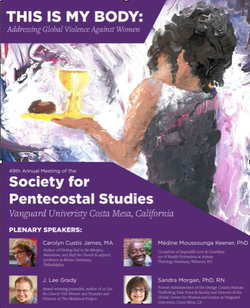|
Here's an excerpt from my paper, A Case Study in Practical Theology, Addressing Economic Violence Towards Women: Three Considerations, which will be presented at the Society of Pentecostal Studies, in Los Angeles. A working theological female anthropology served as a theological motivation that calibrated our applied economic wisdom. Broadly speaking economist talk about the notion of homo economicus as a concept of viewing human beings as rational and self-interested individuals who purse wealth solely by maximizing outcomes. It is considered to be first used by John Stuart Mills in 1836, in an essay “On the definition of Political Economy and on the method of investigation proper to it". Where he states, "[Political economy] does not treat the whole of man’s nature as modified by the social state, nor of the whole conduct of man in society. It is concerned with him solely as a being who desires to possess wealth, and who is capable of judging the comparative efficacy of means for obtaining that end." [1] Adam Smith states, “It is not from the benevolence of the butcher, the brewer, or the baker that we expect our dinner, but from their regard to their own interest.”[2] As much debated as this concept is and that many sociologist, psychologists and economists argue that there are structural impediments to why self-interest is not carried out or simply disagree with the anthropological construction. The reality is though most economic life is based on this notion. A significant pastoral challenge arises when working with these women through an “economic salvation experience”, if you will, which is one moving them from homo economicus, “I work to survive” to a homo imago Dei reality of “I am made in the image of God and I have a part of a flourishing in this world”. Brian Fikkert, of the Chalmers Center states, “…Economic exchange is essential for human flourishing, enabling humans to specialize according to their individual gifts and callings in order to jointly steward God’s creation.”[3] Helping these three women to think deeply and spiritually about how they are made in the homo imago dei and the image contribution looks like in an economic exchange for their flourishing of their families. This has been a turning point not only in their practical economic life but in their spiritual formation.  Much of our historical understanding of the imago dei has been built around male identity and then described in language of “subduing” the earth. This is been a pastoral blind spot for myself because I have never really thought about female notions of imago dei until I came to this point with these three women. This experience has forced me to think differently and see imago dei in terms of relationship. Megan DeFranza notes, "Although he was not the first to do so, Karl Barth (1886-1968) is often credited for challenging the traditional interpretations of the imago Dei. Rather than understanding the image as the soul’s ability to reason, or human responsibility to rule over creation, Barth looked to the creation of Adam and Eve as a symbolic picture, an image of the Trinity. In Genesis 1:26, God said, “Let us make humankind in our image,” and then what does God make? Not one but two, a man and a woman, who are to “become one flesh” (Gen. 2:24 NRSV). Just as God is a plurality and unity, three in one, so humankind, created in God’s image, exists as two who are called to become one. Thus, after Barth, we find that human sex difference and human sexuality (the means by which these two become one) are being taken up into theological accounts of what it means to be made in the image of God.[4]" Mary McClintock Fulkerson notes that the image of God is a weighty doctrine because “the image is a symbolic condensation of what in the Christian tradition means to be fully human. In important respects the imago Dei can serve as an index of whom the tradition has seen as fully human.”[5] Such a thought is a pastoral reality check and especially important for Pentecostal praxis in church life. As Joy Qualls, of Biola University recounts us, “In the early years, Pentecostalism was committed to all people as equal participants specially the marginalized. Women, the poor, those with little formal education, people of color worked and worship with people of financial means and cultural status. Each had a place in an obligation and spreading the Pentecostal message”.[6] As we were given pastoral permission to be involved at a deeper detail of these women’s lives, we began to see the subversive nature of what we were attempting to do. I remember clearly there was a time in reflection where I came to grips that it is not enough to care for the spiritual and emotional life we must have direct intervention and these women’s economic life. One of the matriarchs of our modern Pentecostal movement Cheryl Bridges John’s notes that Pentecostalism is subversive and revolutionary movement, had a dual prophetic role: denouncing the dominant patterns of the status quo and announcing the patterns of God’s order.[7] These women benefited greatly when we begin to operationalize these new patterns of God’s order. [1] Mill, John Stuart. "On the Definition of Political Economy, and on the Method of Investigation Proper to It," Essays on Some Unsettled Questions of Political Economy. [2] Smith, Adam. “On the Division of Labour,” The Wealth of Nations, Books I–III. 1986 [3] Brian Fikkert and Michael Rhodes, "Homo Economicus Versus Homo Imago Dei," Journal of Markets & Morality 20, no. 1 (Spring 2017 [4] DeFranza, Megan K. Sex Difference in Christian Theology: Male, Female, and Intersex in the Image of God, 2015. [5] Mary McClintock Fulkerson, “The Imago Dei and a Reformed Logic for Feminist/Womanist Critique,” in Feminist and Womanist Essays in Reformed Dogmatics, 95. [6] Qualls, Joy E. God Forgive Us for Being Women: Rhetoric, Theology, and the Pentecostal Tradition, 2018. [7] Johns, Cheryl B. "The Adolescence of Pentecostalism: In Search of a Legitimate Sectarian Identity." Pneuma 17, no. 1 (1995) |
bio:+ Economic Theologian |


 RSS Feed
RSS Feed